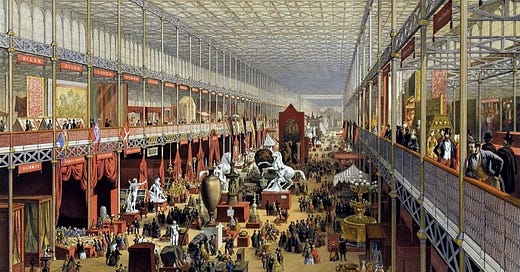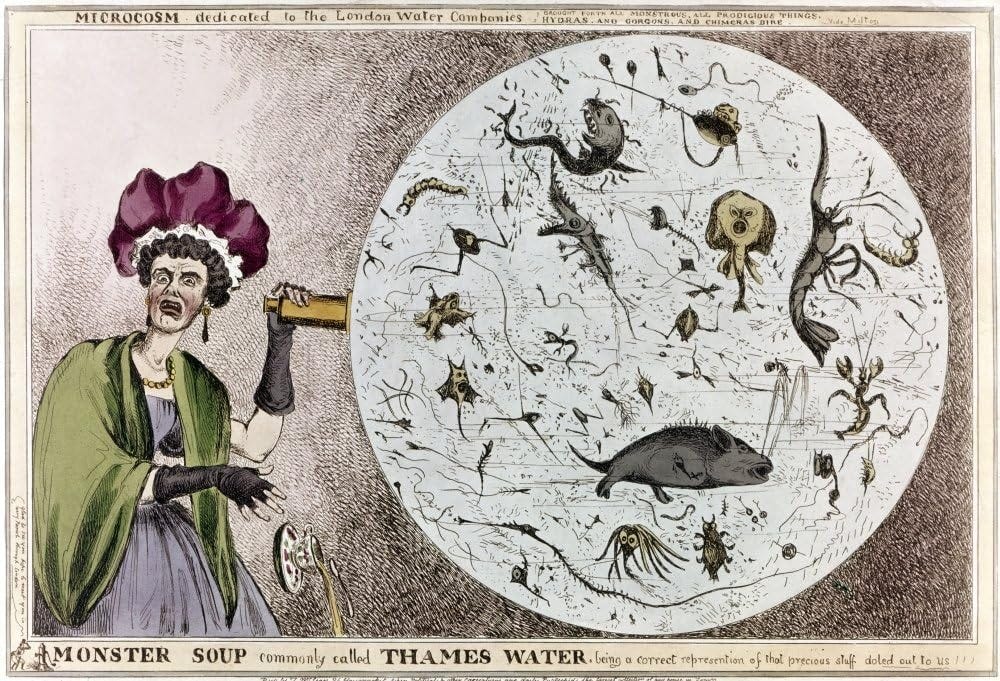#1 Welcome to the Secret Toilet
welcome to this substack and the victorian toilet that I can't stop thinking about.
This substack has been a long time coming. This substack ‘launched’ more than a year ago at a moment of high expectations and poor timing. My writing practice (and myself) needed some time to incubate and now we’re finally ready.
I’m an interdisciplinary artist, thinker, writer, and weirdo. Writing has always been part of my practice, but only recently have I realized how fundamental it is and it ties everything together. I give presentations all the time to my friends, and occasionally at an esteemed academic conference or two (Kimposium, Swiftposium). I do curatorial experiments periodically. I make paintings. I make weird digital content. And I write. This is finally the place for all of these things to live together.
I have my hands in a lot of pots.
This is where all the pots can get their attention.
Whether tiny teapots of giant amphoras.
Why is this substack called “the Secret Toilet?”
Let’s go back to London and the Great Exhibition of 1851 aka the Great Exhibition of Works of Industry of All Nations aka the Crystal Palace, aka the start of the trend of World’s Fairs that would last for over a century (and still continue to this day). From May to October of 1851, over 6 million people passed through the glass and iron halls of the Great Exhibition’s Crystal Palace. It was a celebration, or rather a flaunting of modern design and industry meant to display the industrial and colonial dominance of the British Empire.
Art! Technology! Blatant & over-the-top colonialism!
While there were over 100,000 exhibitions from around the globe to view, there was one bit of cutting edge technology that any visitor to the exhibition could use, provided you had a penny. That penny granted your entrance to a small ornate private room with a towel, a comb, shoe shine, and most important of all - a clean flushing toilet. The first paid-to-use flushing toilet in the UK was in a small private room in a public building amongst hundreds of strangers and exhibits.
As Edward Hollis writes in his brilliant book on lost interiors The Memory Palace, this was “the most visited – and the most profitable – exhibit in the whole of the Great Exhibition. In twenty-three weeks, 827,280 people visited them, and they made a profit of £1790, since everyone who went in had to pay a penny for the privilege. No apology was needed. They were among the most popular interiors in the whole of the Crystal Palace, as ‘they’ must be in all public interiors; but they did not appear in the Queen’s diary. Punch published no cartoons of them, and no engravings appeared in any catalog. We are left with no record of their character, other than a euphemism,,,.
….The water closet was the meeting place between cold china, polished brass, encaustic tile, and quivering, shivering buttock. No wonder no-one wanted to recall the experience.”
This private flushing toilet at the Great Exhibition was something so popular, so formative and fundamental and now so forgotten.
Let’s put this experience in some context. Mid-19th century Great Britain: there’s a massive population explosion. Along with this, comes a human waste explosion. ..but the infrastructure stayed relatively the same with as many as 100 people sharing a single toilet. Sewage was EVERYWHERE. Not only were the streets and rivers of London extremely gross, they were also extremely dangerous. Devastating cholera outbreaks swept the city in the 1830’s and again in 1850’s.
And then there’s the Great Exhibition and then there’s this bathroom. Amongst revolutionary technology and wonders such as kitchen appliances, daguerreotypes, a predecessor to the fax machine, a jacquard loom and the infamous Koh-i-Noor diamond, here was the real beacon of hope. A small private room, where your waste and its associated fears could be flushed away in an instant. For the nearly million visitors that used this toilet, this would have been an unforgettable experience in their lives.
Some of the most seen, most touched, most experienced things in human life are the things that aren't preserved because we don’t think they're worthy of preservation or because of their current ubiquity we assume they will always be there. I often think about iconic gifs that were everywhere 10 years ago but have already sunk into the darkest recesses of the internet to decay and disappear. It’s all the little things that often go unrecorded by history but we ultimately absorb into our cultural landscapes without our notice. What we are always thinking about when we are not really thinking. The microplastics of miscellanea that make us up on a molecular level.
This substack is a place on the internet for discussing, digesting these (and whatever else may strike my current fancy).
We make no effort to remember what we already know, but what if we tried to?
Welcome to the Secret Toilet.
……
I LOVE BOOKS. Here’s some recommended reading that helped inspire this post.
.
The Memory Palace: A Book of Lost Interiors by Edward Hollis
At Home: A Short History of Private Life by Bill Bryson








Excellent writing & research!
Thanks, Len
Trivia fact check:
World Fairs are still happening, though they have morphed.
https://en.wikipedia.org/wiki/World%27s_fair